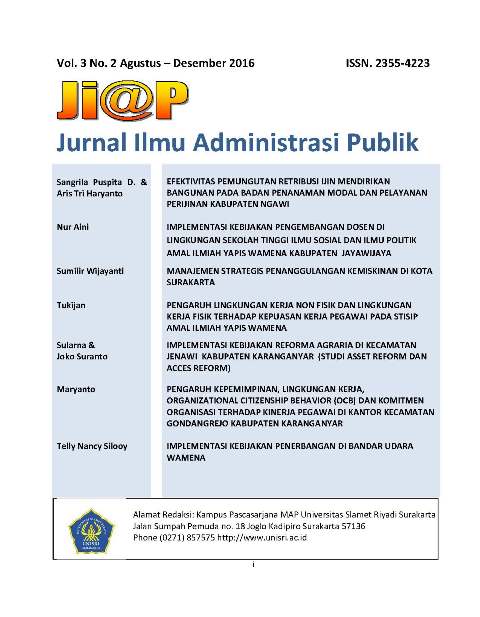MANAJEMEN STRATEGIS PENANGGULANGAN KEMISKINAN DI KOTA SURAKARTA
DOI:
https://doi.org/10.33061/jp.v3i2.1371Abstract
Surakarta development policy has a priority in poverty reduction as the
elaboration in Vision Mission Mayor and Deputy Mayor. The poverty rate
Surakarta in 2010 amounted to 14.99%. Performance targets set in 2015 by
10% with realization amounted to 10.97%. The performance targets set for
poverty reduction RPJMD Surakarta 2016-2021 City at 7.5%. This is the
underlying authors conducted a study analysis of strategic management for
poverty reduction in Surakarta covering (strategy formulation, strategy
implementation and assessment strategies) to describe poverty in Surakarta and
what might be causing long-term targets are set is not reached.
The study authors conducted a qualitative study with research sites in the
Secretariat TKPKD Surakarta and Village (Gajahan, Serengan, Pajang, Sumber
and Kepatihan Wetan). The poverty problem in Surakarta identified include
issues (health, education, employment, food security and basic welfare
infrastructure).
The findings of the study of strategic management for poverty reduction in
Surakarta, that : (1) in the formulation of the strategy, there are three factors
that need attention : a. factor analysis of the external environment in order of
priority on social issues, population and environment, b. factor internal
analysis in order to focus on CSR's participation in the allocation of resources,
c. The annual target-setting by the functional division can be selected as the
basis for their next strategy. (2) in the implementation of the strategy there are
two factors, that : a. integration of the functional division pattern is not clearly
visible, is still partial and sectorial, for it needs to develop a correlation with a
focus target poor people in the village with the highest poverty pockets, b.
providing access to information and education to the poor, the development of
innovation to be equipped with operational support, and the need to build an
integrated system as well as providing space for public participation. (3) in the
assessment of the strategy, there are two factors that : a. need consistency that
the target of achieving long-term has not translated into the realization of the
annual target of a functional division implementing poverty reduction
programs, b. to be reviewed the appropriateness and feasibility beneficiaries of
poverty alleviation programs associated with the administration of residence,
and c. dalah potential competitive advantage and the vocational culture can be
developed as a solution to poverty reduction.
Keywords : Strategy, Formulation, Implementation, Assessment Strategies and
Achieving Performance
Downloads
Published
How to Cite
Issue
Section
License
Authors who publish this journal agree to the following terms:
- Authors retain copyright and grant the journal right of first publication with the work simultaneously licensed under a Creative Commons Attribution License that allows others to share the work with an acknowledgement of the work's authorship and initial publication in this journal.
- Authors can separately make additional contractual arrangements for non-exclusive distribution published by the journal (e.g., publish it in a book), with an acknowledgement of its initial publication in this journal.
- Authors are allowed and encouraged to send their work via online (e.g., in the institutional repositories or their website) after published by the journal.













